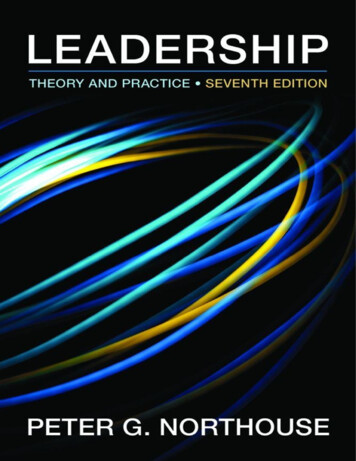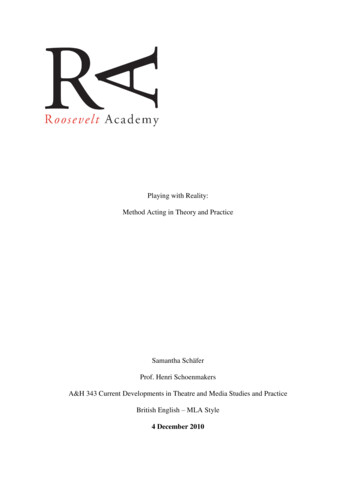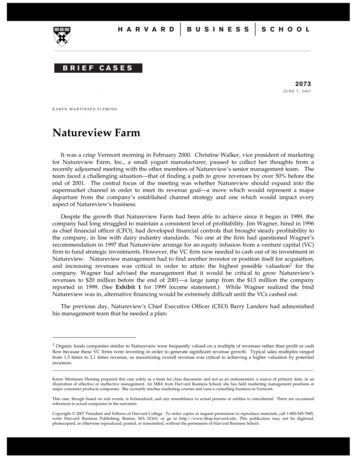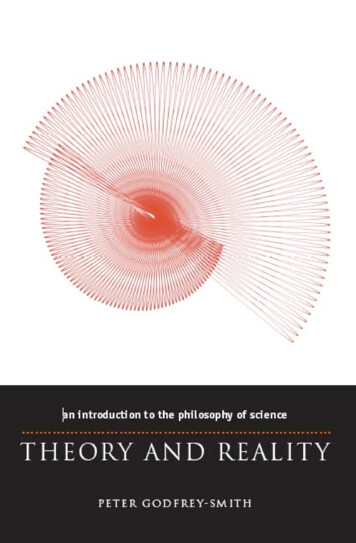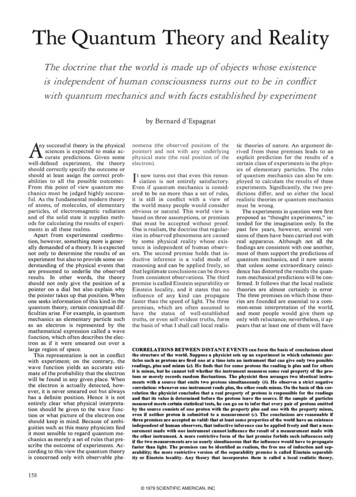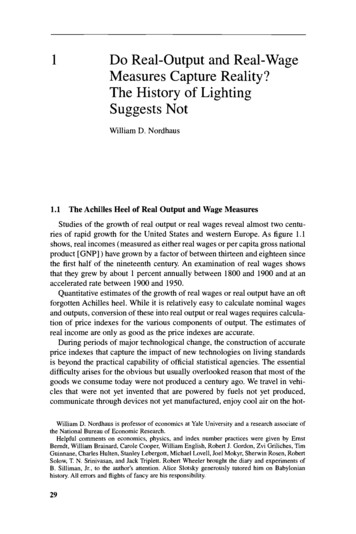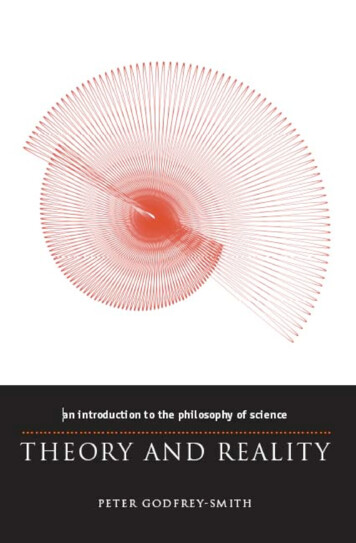
Transcription
Theory and Reality
S C I E N C E A N D I T S C O N C E P T U A L F O U N D A T I O N S A S E R I E S E D I T E D B Y D AV I D L . H U L L
an introduction to the philosophy of science THEORY AND REALITY P E T E R G O D F R E Y- S M I T HThe University of Chicago Press / Chicago and London
Peter Godfrey-Smith is associate professor of philosophy and of history and philosophy of science at Stanford University. He is the authorof Complexity and the Function of Mind in Nature.The University of Chicago Press, Chicago 60637The University of Chicago Press, Ltd., London 2003 by The University of ChicagoAll rights reserved. Published 2003Printed in the United States of America12 11 10 09 08 07 06 05 04 0312345isbn: 0-226-30062-5 (cloth)isbn: 0-226-30063-3 (paper)Library of Congress Cataloging-in-Publication DataGodfrey-Smith, Peter.Theory and reality : an introduction to the philosophy of science /Peter Godfrey-Smith.p. cm. — (Science and its conceptual foundations)Includes bibliographical references and index.isbn 0-226-30062-5 (alk. paper) — isbn 0-226-30063-3 (pbk. : alk.paper)1. Science—Philosophy. I. Title. II. Series.q175 .g596 2003501—dc212002155305o The paper used in this publication meets the minimum requirementsof the American National Standard for Information Sciences—Permanence of Paper for Printed Library Materials, ansi z39.48-1992.
For my parents
ContentsPreface xiA Note for Those Teaching with the Book1Introduction1.11.21.31.41.5241 19The Empiricist Tradition 19The Vienna Circle 22Central Ideas of Logical Positivism 25Problems and Changes 30Logical Empiricism 34On the Fall of Logical Empiricism 37Further Reading 37Induction and Confirmation3.13.23.33.4xiiiSetting Out 1The Scope of the Theory 2What Kind of Theory? 5Three Answers, or Pieces of an Answer 8Historical Interlude: A Sketch of the Scientific Revolution 13Further Reading 18Logic Plus Empiricism2.12.22.32.42.52.63 39The Mother of All Problems 39Induction, Deduction, Confirmation, and Explanatory Inference 40The Ravens Problem 46Goodman’s “New Riddle of Induction” 50Further Reading 56Popper: Conjecture and Refutation 574.1 Popper’s Unique Place in the Philosophy of Science 574.2 Popper’s Theory of Science 57
viii Contents4.34.44.54.65Kuhn and Normal Science5.15.25.35.45.56 87Considerable Upset 87Revolutions and Their Aftermath 88Incommensurability, Relativism, and Progress 91The X-Rated “Chapter X” 96Final Thoughts on Kuhn 98Further Reading 101 102After Structure 102Lakatos and Research Programs 103Laudan and Research Traditions 108Anything Goes 110An Argument from History That Haunts Philosophy 113Pluralism and the Ramblings of Madmen 115Taking Stock: Frameworks and Two-Process Theories of Science 117Further Reading 121The Challenge from Sociology of Science8.18.28.38.4975Lakatos, Laudan, Feyerabend, and Frameworks7.17.27.37.47.57.67.78 “The Paradigm Has Shifted” 75Paradigms: A Closer Look 77Normal Science 79Anomaly and Crisis 82Wrap-up of Normal Science 84Further Reading 86Kuhn and Revolutions6.16.26.36.46.57Popper on Scientific Change 61Objections to Popper on Falsification 63Objections to Popper on Confirmation 67Further Comments on the Demarcation Problem 71Further Reading 74 122Beyond Philosophy? 122Robert Merton and the “Old” Sociology of Science 122The Rise of the Strong Program 125Leviathan and Latour 128Further Reading 135Feminism and Science Studies9.1 “Science Is Political” 1369.2 The Man of Reason 137 136
Contents ix9.3 The Case of Primatology 1399.4 Feminist Epistemology 1419.5 Science Studies, the Science Wars, and the Sokal Hoax 144Further Reading 14810Naturalistic Philosophy in Theory and Practice 149 16310.1 What Is Naturalism? 14910.2 Quine, Dewey, and Others 15010.3 The Theory-Ladenness of Observation 155Further Reading 16211Naturalism and the Social Structure of Science11.1 Science as a Process 16311.2 Kitcher and the Division of Scientific Labor 16711.3 Social Structure and Empiricism 169Further Reading 17212Scientific Realism12.112.212.312.412.512.612.71314173Strange Debates 173Approaching Scientific Realism 174A Statement of Scientific Realism 174Challenges from Traditional Empiricism 180Metaphysical Constructivism 181Van Fraassen’s View 183Representation, Models, and Truth (Optional Section) 186Further Reading 189Explanation13.113.213.313.4 190Knowing Why 190The Rise and Fall of the Covering Law Theory of Explanation 191Causation, Unification, and More 194Laws and Causes (Optional Section) 200Further Reading 201Bayesianism and Modern Theories of Evidence14.114.214.314.414.514.6 202New Hope 202Understanding Evidence with Probability 203The Subjectivist Interpretation of Probability 205Assessing Bayesianism 208Scientific Realism and Theories of Evidence 210Procedural Naturalism (Optional Section) 214Further Reading 217
x15ContentsEmpiricism, Naturalism, and Scientific Realism?15.115.215.315.415.5A Muddy Paste? 219The Apparent Tensions 220Empiricism Reformed 221A Last Challenge 227The Future 230Glossary 233References 243Index 255 219
PrefaceThis book is based mainly on lectures given at Stanford University duringthe last eleven years. So the book is a distillation of lectures, but not onlyof lectures. It also bears the influence of innumerable comments, questions,and papers by students over that time, together with remarks made by colleagues and friends.The book is written primarily for students, but it is intended to be accessible to a fairly wide audience. I assume no background knowledge inphilosophy at all in the reader. My primary aim is to introduce some of themain themes in the philosophy of science, while simultaneously telling anaccessible and interesting story about how the field has developed in thelast one hundred years or so. In telling this story I have been led to describethe connections between philosophy and other disciplines, and the changing intellectual climate in which theories of science have been offered, inmore detail than many introductory books do. I have also tried, in someplaces, to capture some of the atmosphere of the debates, and the personalities of the protagonists.Another aim of the book is the outline and defense of a particular pointof view, but I have concentrated that discussion mostly in the final third ofthe book. Philosophy of science seems to me to be still in a state of considerable ferment. That poses a choice for the author of a book like this; onecan either abstract away from the disorder and uncertainty, and lay downone particular vision, or one can use the disputes to tell a story about thefield—how did we get to where we are now? I have mostly chosen the latterapproach. This feature of the book is partly due to the inspiration of JohnHeilbroner’s classic history of economic thought, The Worldly Philosophers.For comments on this work I am very grateful to Fiona Cowie, MichaelDevitt, Stephen Downes, Richard Francis, Michael Friedman, Lori Gruen,Tania Lombrozo, Denis Philips, J. D. Trout, Allen Wood, and Rega Wood.xi
xii PrefaceTwo anonymous referees for the University of Chicago Press also madehelpful criticisms.For detailed and exceptionally useful comments on entire near-finaldrafts, resulting in numerous improvements, I am indebted to Karen Bennett, Kim Sterelny, and Michael Weisberg.Other improvements resulted, as always, from the insight, good sense,deft touch, and unique perspective of David Hull, the editor of the Scienceand Its Conceptual Foundations series. At the University of Chicago Press,Susan Abrams was constantly enthusiastic about the project and did a greatjob throughout. It is a rare pleasure to work with an editor like Susan. I amalso grateful to Stanford University for much financial and intellectual support over the last eleven years. This support has included several grants, including most recently a Martha Sutton Weeks Fellowship.Finally, as this is a book written primarily for students, this seems an appropriate place for me to express my enduring gratitude to the four fundamental mentors who taught, guided, and encouraged me when I was a student: Kim Sterelny, Michael Devitt, Stephen Stich, and Philip Kitcher.
A Note for Those Teaching with the BookThe book is organized chronologically, especially until chapter 10, and following the chronology is probably the most appropriate way to teach acourse using the book. However, there is also a way to use the book in acourse that follows a more thematic organization. Approached this way,chapters 1 and 2 are background; chapters 3, 4, 10, and 14 form a blockfocused on issues about evidence, testing, and theory choice; chapters 5–11 discuss scientific change and the social organization of science, alongwith the interaction between these topics and epistemological questions;chapters 12 and 13 address issues more on the metaphysical than the epistemological side of the philosophy of science. The book might also be used,of course, as a supplement to lectures and readings with a very different organization.The “Further Reading” sections tend to contain quite a lot of primarymaterial, including some difficult works and works intended to give the flavor of recent discussion (such as papers from the Proceedings of the Philosophy of Science Association). This is especially true of the later chapters.The level of difficulty found in the “Further Reading” escalates morequickly than the difficulty of the text itself (or so I hope). The glossary, incontrast, is intended to be very elementary, a tool for those coming to thebook with little or no background in the area.xiii
1 Introduction1.1 Setting OutThis book is a survey of roughly one hundred years of argument about thenature of science. We’ll look at a hundred years of argument about whatscience is, how it works, and what makes science different from other waysof investigating the world. Most of the ideas we will examine fall into thefield called “philosophy of science,” but we will also spend a good deal oftime looking at ideas developed by historians, sociologists, psychologists,and others.The book mostly has the form of a “grand tour” through the decades;ideas will be discussed in roughly the order in which they appeared. Note theword “roughly” in the previous sentence; there are exceptions to the historical structuring of the book, and I will point out some of them as they arise.Why is it best to start with older ideas and work through to the present?One reason is that the historical development of general ideas about science is itself an interesting topic. Another reason is that the philosophy ofscience has been in a state of fermentation and uncertainty in recent years.A good way to understand the maze of options and opinions in the field atthe moment is to trace the path that brought us to the state we’re in now.But this book does not only aim to introduce the options. I will often takesides as we go along, trying to indicate which developments were probablywrong turns or red herrings. Other ideas will be singled out as being on theright track. Then toward the end of the book, I will start trying to put thepieces together into a picture of how science works.Philosophy is an attempt to ask and answer some very basic questionsabout the universe and our place within it. These questions can sometimesseem far removed from practical concerns. But the debates covered in thisbook are not of that kind. Though these debates are connected to the mostabstract questions about thought, knowledge, language, and reality, they1
2Chapter Onehave also turned out to have an importance that extends well outside ofphilosophy. They have made a difference to developments in many other academic fields, and some of the debates have reverberated much further, affecting discussions of education, medicine, and the proper place of sciencein society.In fact, throughout the latter part of the twentieth century, all the fieldsconcerned with the nature of science went on something of a roller-coasterride. Some people thought that work in the history, philosophy, and sociology of science had shown that science does not deserve the dominatingrole it has acquired in Western cultures. They thought that a set of mythsabout the trustworthiness and superiority of mainstream science had beenthoroughly undermined. Others disagreed, of course, and the resulting debates swirled across the intellectual scene, frequently entering political discussion as well. From time to time, scientific work itself was affected, especially in the social sciences. These debates came to be known as the “ScienceWars,” a phrase that conveys a sense of how heated things became.The Science Wars eventually cooled down, but now, as I write thesewords, it is fair to say that there is still a great deal of disagreement abouteven the most basic questions concerning the nature and status of scientificknowledge. These disagreements usually do not have much influence onthe day-to-day practice of science, but sometimes they do. And they havehuge importance for general discussions of human knowledge, culturalchange, and our overall place in the universe. This book aims to introduceyou to this remarkable series of debates, and to give you an understandingof the present situation.1.2 The Scope of the TheoryIf we want to understand how science works, it seems that the first thingwe need to do is work out what exactly we are trying to explain. Wheredoes science begin and end? Which kinds of activity count as “science”?Unfortunately this is not something we can settle in advance. There is alot of disagreement about what counts as science, and these disagreementsare connected to all the other issues discussed in this book.There is consensus about some central cases. People often think ofphysics as the purest example of science. Certainly physics has had a heroichistory and a central role in the development of modern science. Molecular biology, however, is probably the science that has developed most rapidly and impressively over the past fifty years or so.These seem to be central examples of science, though even here we en-
Introduction 3counter hints of controversy. A few have suggested that theoretical physicsis becoming less “scientific” than it used to be, as it is evolving into an esoteric, mathematical model–building exercise that has little contact withthe real world (Horgan 1996). And molecular biology has recently beenacquiring connections with business and industry that make it, in the eyesof some, a less exemplary science than it once was. Still, examples likethese give us a natural starting point. The work done by physicists and molecular biologists when they test hypotheses is science. And playing a gameof basketball, no matter how well one plays, is not doing science. But in thearea between these clear cases, disagreement reigns.At one time the classification of economics and psychology as scienceswas controversial. Those fields have now settled into a scientific status, atleast within the United States and similar countries. (Economics retains anamusing qualifier; it is often called “the dismal science,” a phrase due toThomas Carlyle.) There is still a much-debated border region, however,and at the moment this includes areas like anthropology and archaeology.At Stanford University, where I teach, this kind of debate was one elementof a process in which the Department of Anthropology split into two separate departments. Is anthropology, the general study of humankind, afully scientific discipline that should be closely linked to biology, or is it amore “interpretive” discipline that should be more closely connected to thehumanities?The existence of this gray area should not be surprising, because in contemporary society the word “science” is a loaded and rhetorically powerfulone. People will often find it a useful tactic to describe work in a borderline area as “scientific” or as “unscientific.” Some will call a field scientificto suggest that it uses rigorous methods and hence delivers results weshould trust. Less commonly, but occasionally, a person might call an investigation scientific in order to say something negative about it—to suggest that it is dehumanizing, perhaps. (The term “scientistic” is more oftenused when a negative impression is to be conveyed.) Because the words“science” and “scientific” have these rhetorical uses, we should not be surprised that people constantly argue back and forth about which kinds ofintellectual work count as science.The history of the term “science” is also relevant here. The current usesof the words “science” and “scientist” developed quite recently. The word“science” is derived from the Latin word “scientia.” In the ancient, medieval, and early modern world, “scientia” referred to the results of logicaldemonstrations that revealed general and necessary truths. Scientia could begained in various fields, but the kind of proof involved was what we would
4Chapter Onenow mostly associate with mathematics and geometry. Around the seventeenth century, when modern science began its rise, the fields that we wouldnow call science were more usually called “natural philosophy” (physics,astronomy, and other inquiries into the causes of things) or “natural history” (botany, zoology, and other descriptions of the contents of the world).Over time, the term “science” came to be used for work with closer links toobservation and experiment, and the association between science and anideal of conclusive proof receded. The current senses of the term “science”and the associated word “scientist” are products of the nineteenth century.Given the rhetorical load carried by the word “science,” we should notexpect to be able to lay down, here in chapter 1, an agreed-on list of whatis included in science and what is not. For now we will have to let the grayarea remain gray.A further complication comes from the fact that philosophical (andother) theories differ a lot in how broadly they conceive of science. Somewriters use terms like “science” or “scientific” for any work that assessesideas and solves problems in a way guided by observational evidence. Science is seen as something found in all human cultures, even though theword is a Western invention. But there are also views that construe “science” more narrowly, seeing it as a cultural phenomenon that is localizedin space and time. For views of this kind, it was only the Scientific Revolution of the sixteenth and seventeenth centuries in Europe that gave us science in the full sense. Before that, we find the initial “roots” or precursorsof science in ancient Greece, some contributions from the Arab world andfrom the Scholastic tradition in the late Middle Ages, but not much else. Sothis is a view in which science is treated as a special social institution witha definite history. Science is something that descends from specific peopleand places, and especially from a key collection of Europeans, includingCopernicus, Kepler, Galileo, Descartes, Boyle, and Newton, who all livedin the sixteenth and seventeenth centuries.To set things up this way is to see science as unlike the kinds of investigation and knowledge that routinely go along with farming, architecture,and other kinds of technology. So a view like this need not claim thatpeople in nonscientific cultures must be ignorant or stupid; the idea is thatin order to understand science, we need to distinguish it from other kindsof investigation of the world. And we need to work out how one approachto knowledge developed by a small group of Europeans turned out to havesuch spectacular consequences for humanity.As we move from theory to theory in this book, we will find some peopleconstruing science broadly, others narrowly, and others in a way that lies inbetween. But this does not stop us from outlining, in advance, what kind
Introduction 5of understanding we would eventually like to have. However we choose touse the word “science,” in the end we should try to develop both1. a general understanding of how humans gain knowledge of the world aroundthem and2. an understanding of what makes the work descended from the Scientific Revolution different from other kinds of investigation of the world.We will move back and forth between these two kinds of questions throughout the book.Before leaving this topic, there is one other possibility that should bementioned. How confident should we be that all the work we call “science,” even in the narrower sense described above, has that much in common? One of the hazards of philosophy is the temptation to come up withtheories that are too broad and sweeping. “Theories of science” need to bescrutinized with this problem in mind.1.3 What Kind of Theory?This book is an introduction to the philosophy of science. But most of thebook focuses on one set of issues in that field. Within the philosophy of science, we can distinguish between epistemological issues and metaphysicalissues (as well as issues that fall into neither category). Epistemology is theside of philosophy that is concerned with questions about knowledge, evidence, and rationality. Metaphysics, a more controversial part of philosophy, deals with general questions about the nature of reality. Philosophyof science overlaps with both of these.Most of the issues discussed in this book are, broadly speaking, epistemological issues. For example, we will be concerned with questions abouthow observational evidence can justify a scientific theory. We will also askwhether we have reason to hope that science can succeed in describing theworld “as it really is.” But we will occasionally encounter metaphysical issues, and issues in the philosophy of language. The discussion will intersectwith work in the history of science and other fields as well.All of philosophy is plagued with discussion and anxiety about howphilosophical work should be done and what a philosophical theory shouldtry to do. So we will have to deal with disagreement about the right formfor a philosophical theory of science, and disagreement about which questions philosophers should be asking. One obvious possibility is that wemight try for an understanding of scientific thinking. In the twentieth century, many philosophers rejected this idea, insisting that we should seek a
6Chapter Onelogical theory of science. That is, we should try to understand the abstractstructure of scientific theories and the relationships between theories andevidence. A third option is that we should try to come up with a methodology, a set of rules or procedures that scientists do or should follow. Inmore recent years, philosophers influenced by historical work have wantedto give a general theory of scientific change.A distinction that is very important here is the distinction between descriptive and normative theories. A descriptive theory is an attempt to describe what actually goes on, or what something is like, without makingvalue judgments. A normative theory does make value judgments; it talksabout what should go on, or what things should be like. Some theoriesabout science are supposed to be descriptive only. But most of the views wewill look at do have a normative element, either officially or unofficially.When assessing general claims about science, it is a good principle to constantly ask: “Is this claim intended to be descriptive or normative, or both?”For some people, the crucial question we need to answer about scienceis whether or not it is “objective.” But this term has become an extremelyslippery one, used to mean a number of very different things. Sometimesobjectivity is taken to mean the absence of bias; objectivity is impartialityor fairness. But the term “objective” is also often used to express claimsabout whether the existence of something is independent of our minds. Aperson might wonder whether there really is an “objective reality,” that isto say, a reality that exists regardless of how people conceptualize or describe it. We might ask whether scientific theories can ever describe a reality that exists in this sense. Questions like that go far beyond any issueabout the absence of bias and take us into deep philosophical waters.Because of these ambiguities, I will often avoid the terms “objective”and “objectivity.” But the questions that tend to be asked using those termswill be addressed, using different language, throughout the book. And Iwill return to “objectivity” in the final chapter.Another famous phrase is “scientific method.” Perhaps this is what mostpeople have in mind when they imagine giving a general theory of science.The idea of describing a special method that scientists do or should follow isold. In the seventeenth century, Francis Bacon and René Descartes, amongothers, tried to give detailed specifications of how scientists should proceed.Although describing a special scientific method looks like a natural thing totry to do, during the twentieth century many philosophers and others became skeptical about the idea of giving anything like a recipe for science. Science, it was argued, is too creative and unpredictable a process for there tobe a recipe that describes it—this is especially true in the case of great scientists like Newton, Darwin, and Einstein. For a long time it was common for
Introduction 7science textbooks to have an early section describing “the scientific method,”but recently textbooks seem to have become more cautious about this.I said that much twentieth-century philosophy of science aimed at describing the logical structure of science. What does this mean? The idea isthat the philosopher should think of a scientific theory as an abstract structure, something like a set of interrelated sentences. The philosopher aimsto give a description of the logical relations between the sentences in thetheory and the relations between the theory and observational evidence.Philosophy can also try to describe the logical relations between differentscientific theories in related fields.Philosophers taking this approach tend to be enthusiastic about the toolsof mathematical logic. They prize the rigor of their work. This kind of philosophy has often prompted frustration in people working on the actualhistory and social structure of science. The crusty old philosophers seemedto be deliberately removing their work from any contact with science as itis actually conducted, perhaps in order to hang onto a set of myths aboutthe perfect rationality of the scientific enterprise, or in order to have nothing interfere with the endless games that can be played with imaginary theories expressed in artificial languages. This kind of logic-based philosophyof science will be discussed in the early chapters of this book. I will arguethat the logical investigations were often very interesting, but ultimatelymy sympathy lies with those who insist that philosophy of science shouldhave more contact with actual scientific work.If looking for a recipe is too simplistic, and looking for a logical theoryis too abstract, what might we look for instead? Here is an answer that willbe gradually developed as the book goes on: we can try to describe the scientific strategy for investigating the world. And we can then hope to describe what sort of connection to the world we are likely to achieve by following that strategy. Initially, this may sound vague or impossible, or both.But by the end of the book I hope to show that it makes good sense.Several times now I have mentioned fields that “neighbor” on philosophy of science—history of science, sociology of science, and parts of psychology, for example. What is the relation between philosophical theoriesof science and ideas in these neighboring fields? This question was part ofthe twentieth-century roller-coaster ride that I referred to earlier. Somepeople in these neighboring fields thought they had reason to believe thatthe whole idea of a philosophical theory of science is misguided. They expected that philosophy of science would be replaced by fields like sociology.This replacement never occurred. What did happen was that people in theseneighboring fields constantly found themselves doing philosophy themselves, whether they realized it or not. They kept running into questions
8Chapter Oneabout truth, about justification, and about the connections between theories and reality. The philosophical problems refused to go away.Philosophers themselves differ a great deal about what kind of inputfrom these neighboring fields is relevant to philosophy. This book is written from a viewpoint that holds that philosophy of science benefits fromlots of input from other fields. But the argument that philosophy of scienceneeds that kind of input will not be given until chapter 10.1.4 Three Answers, or Pieces of an AnswerIn this section I will introduce three different answers to our general questions about how science works. In different ways, these three ideas will berecurring themes throughout the book.The three ideas can be seen as rivals; they can be seen as alternativestarting points, or paths into the problem. But they might instead be considered as pieces of a single, more complicated answer. The problem thenbecomes how to fit them together.The first of the three ideas is empiricism. Empiricism encompasses a diverse family of philosophical views, and debates within the empiricistcamp can be intense. But empiricism is often summarized using somethinglike the following slogan:Empiricism: The only source of real knowledge about the world is experience.Empiricism, in this sense, is a view about where all knowledge comes from,not just scientific knowledge. So how does this help us with the philosophyof science? In general, the empiricist tradition has tended to see the differences between science and everyday thinking as differenc
Th eory and reality : an introduction to the philosophy of science / Peter Godfrey-Smith. p. cm. (Science and its conceptual foundations) Includes bibliographical references and index. isbn 0 -226-30062-5 (alk. paper) isbn 0 -226-30063-3 (pbk. : alk. paper) 1. Science Philosophy. I.

